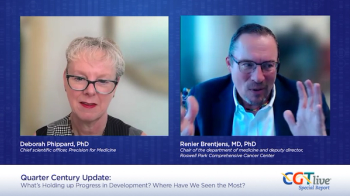
Valoctocogene Roxaparvovec’s Treatment Durability in Hemophilia A in Question
A drop in endogenous Factor VIII expression was observed from treatment to 5-year follow-up despite continued demonstration of efficacy.
Long term data from a phase 1/2 study (NCT04684940) of valoctocogene roxaparvovec (valrox) for the treatment of
Investigators found that the 6 x 1013 vg/kg dose cohort (n = 7) experienced a 95% reduction in mean ABR from baseline to 5 years and a 96% reduction in mean annualized Factor VIII utilization from baseline to 5 years post-treatment. However, Factor VIII activity levels fell from treatment to 5-year follow-up as measured by both chromogenic substrate assay (CSA) and one-stage assay (OSA).
"The consistent and impressive bleed control in the majority of the study participants out to 5 years in this study, which is the longest duration of clinical experience for any gene therapy in hemophilia A, increases our understanding of the interplay between Factor VIII expression, ABR, and Factor VIII infusion rate as it relates to hemostatic efficacy," said principal investigator Michael Laffan, BMBCh, DM, FRCP, FRCPath, professor, Department of Immunology and Inflammation, Imperial College London, and Director, Hammersmith Hospital Haemophilia Centre, in a statement. "These data show that most of the study participants have not had a bleed or had to infuse Factor VIII in the last five years after one infusion of valrox, which has the potential to provide a treatment choice that addresses many of the unmet needs in hemophilia."
The highest dose cohort experienced a reduced mean ABR from 16.3 (median, 16.5) at baseline to 0.8 (median, 0.0) episodes per year among the 6 participants previously treated with FVIII prophylaxis (mean follow-up, 266.1 weeks [5.1 years]). In year 5, 86% (n = 6) of participants in the high dose cohort had no treated bleeds.
READ MORE:
The lower dose cohort (n = 6), treated with 4 x 1013 vg/kg showed that a single infusion of valrox reduced mean ABR by 92% from 12.2 (median, 8.0) at baseline to 1.0 (median, 0.5) bleeding episodes per year (mean follow-up, 218.6 weeks [4.2 years]). In year 4, 50% (n = 3) of participants had no treated bleeds.
High dose cohort participants experienced a 96% reduction in mean annualized Factor VIII utilization from 135.6 (median, 136.5) to 5.2 (median, 0.1) infusions per year among the 6 participants previously treated with FVIII prophylaxis. Lower dose participants experienced a 95% reduction in mean annualized Factor VIII utilization from 142.8 (median, 155.8) to 7.8 (median, 1.4) infusions per year. Exogenous Factor VIII was used as treatment for bleeding, surgery or procedures, and as one-time prophylaxis during follow-up in both cohorts.
Participants in both cohorts continued to experience substantial decline in levels of endogenous Factor VIII expression as confirmed by both CSA and OSA assays. In the low dose cohort, Factor VIII expression decreased from a mean of 5.6 IU/dL (standard deviation [SD], 5.6) to a median of 4.8 IU/dL after 4 years via CSA and from a mean of 9.5 IU/dL (SD, 7.0) to a median of 7.5 IU/dL after 4 years via OSA. In the high dose cohort, Factor VIII expression decreased from a mean of 11.6 IU/dL (SD, 12.2) to a median of 8.2 IU/dL at 5 years via CSA and from a mean of 18.7 IU/dL (SD, 17.5) to a median of 15.7 IU/dL after 5 years.
As of the most recent year of observation, 6 participants in the high dose cohort were in the mild to moderate hemophilia range, and 1 participant was below the lower limit of quantification as measured by CSA. One participant was in the non-hemophilic range, 4 were in the mild range, and 1 was in the moderate range as measured by OSA. Four participants in the low dose cohort were in the mild to moderate hemophilia range, and 2 were below the lower limit of quantification as measured by CSA. All 6 were in the mild to moderate range as measured by OSA.
Valrox has continued to be well-tolerated, with no delayed-onset treatment related adverse events (AEs). All participants continue to remain off corticosteroids since the first year, none developed inhibitors to Factor VIII, and none withdrew from the study. Common AEs included short-lived infusion-associated reactions and transient, asymptomatic, and mild to moderate rise in liver enzymes with no long-lasting clinical sequelae.
"We are optimistic that ABR may be maintained acceptably low through years 3, 4, and 5 after treatment with valrox in the GENEr8-1 study given the predictable, and not sudden or dramatic, change in Factor VIII expression in the later years following treatment in the Phase 1/2 study," added Hank Fuchs, MD, president, Worldwide Research and Development, BioMarin. "The data show excellent hemostatic efficacy in the 6e13 and 4e13 vg/kg dose cohorts, which is maintained into year 5 and 4, respectively. We look forward to sharing topline two-year data from all participants in the pivotal Phase 3 GENEr8-1 study in early 2022."
BioMarin also recently presented
"The demonstrated bleed control at 52 weeks and beyond in this pivotal study supports our thesis that gene therapy can play an important role in the treatment of severe hemophilia A and potentially creates the possibility for a new treatment paradigm," said lead principal investigator Margareth C. Ozelo, MD, PhD, director, INCT do Sangue Hemocentro UNICAMP, University of Campinas, in another statement. "It is encouraging to see meaningful endogenous Factor VIII expression and decreases in bleeding and Factor VIII infusions for people in this study. These pivotal results contribute to the growing body of data to increase understanding of the safety and efficacy of gene therapy treatment over time."
The FDA previously rejected BioMarin’s biologics license application for valrox in August 2020, issuing a complete response letter that cited the need for additional durability data. The FDA requested 2-year follow-up data from the phase 3 study to confirm the durability of the treatment. The last patient in the study will complete 2 years of follow up study in November 2021.3
On the European side, BioMarin resubmitted their marketing authorization application to the European Medicines Agency (EMA) in June 2021 after the EMA granted the company's request for accelerated assessment in May 2021. The agency had previously requested 52-week data from the phase 3 GENEr8-1 study. The EMA Committee for Medicinal Products for Human Use opinion is expected in the first half of 2022.4
REFERENCES
1. BioMarin announces oral presentation at ISTH 2021 Virtual Congress with 5 years of clinical data from ongoing phase 1/2 study of valoctocogene roxaparvovec in adults with severe hemophilia a, demonstrating continued, durable clinical benefit. News release. BioMarin. July 21, 2021. https://www.biospace.com/article/releases/biomarin-announces-oral-presentation-at-isth-2021-virtual-congress-with-5-years-of-clinical-data-from-ongoing-phase-1-2-study-of-valoctocogene-roxaparvovec-in-adults-with-severe-hemophilia-a-demonstrating-continued-durable-clinical-benefit/
2. BioMarin announces oral presentation of positive one-year results from phase 3 pivotal trial with valoctocogene roxaparvovec gene therapy in adults with severe hemophilia A at ISTH 2021 Virtual Congress. News release. BioMarin. July 19, 2021. https://investors.biomarin.com/2021-07-19-BioMarin-Announces-Oral-Presentation-of-Positive-One-Year-Results-from-Phase-3-Pivotal-Trial-with-Valoctocogene-Roxaparvovec-Gene-Therapy-in-Adults-with-Severe-Hemophilia-A-at-International-Society-on-Thrombosis-and-Haemostasis-ISTH-2021-Virtua
3. FDA turns down BioMarin's hemophilia A gene therapy. News release. BioMarin. August 19, 2020. Accessed July 27, 2021. https://www.biospace.com/article/fda-rejects-biomarin-s-hemophilia-a-gene-therapy/
4. BioMarin resubmits marketing authorization application (MAA) to European Medicines Agency for valoctocogene roxaparvovec to treat severe hemophilia A. News release. BioMarin. June 28, 2021. https://www.biospace.com/article/releases/biomarin-resubmits-marketing-authorization-application-maa-to-european-medicines-agency-for-valoctocogene-roxaparvovec-to-treat-severe-hemophilia-a/
Newsletter
Stay at the forefront of cutting-edge science with CGT—your direct line to expert insights, breakthrough data, and real-time coverage of the latest advancements in cell and gene therapy.










































